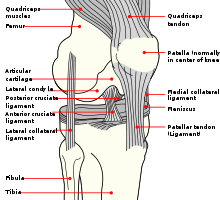- Cruciate ligament
-
Cruciate ligaments (also cruciform ligaments) are pairs of ligaments arranged like a letter X.[1] They occur in several joints of the body, such as the knee. In a fashion similar to the cords in a toy Jacob's ladder, the crossed ligaments stabilize the joint while allowing a very large range of motion.
Contents
Etymology
The adjective cruciate is from the Latin crux, crucis, meaning "cross".
In Classical Latin, the verb cruciare means "to torture". By the time in the Late Latin period when Latin medical terminology was being established, this old meaning of cruciare seems to have fallen out of use in common speech, and the word was re-invented with the meaning "arrange in cross shape". Use of "cruciat-" to refer to torture is now obsolete in English, but this old usage is shown in the common English word excruciating, and in the "Cruciatus" curse in the Harry Potter fictional scenario.
Anatomy
Cruciate ligaments occur in the knee of humans and other bipedal animals and the corresponding stifle of quadrupedal animals, and in the neck, fingers, and foot.
- The cruciate ligaments of the knee are the anterior cruciate ligament (ACL) and the posterior cruciate ligament (PCL). These ligaments are two strong, rounded bands that extend from the head of the tibia to the intercondyloid notch of the femur. The ACL is lateral and the PCL is medial. They cross each other like the limbs of an X. The ACL and PCL remain distinct throughout and each has its own partial synovial sheath. Relative to the femur, the ACL keeps the tibia from slipping forward and the PCL keeps the tibia from slipping backward.
- Another structure of this type in human anatomy is the cruciate ligament of the dens of the atlas vertebra, also called "cruciform ligament of the atlas", a ligament in the neck forming part of the atlanto-axial joint.[2]
- In the fingers, the deep and superficial flexor tendons pass through a fibro-osseous tunnel system – the flexor mechanism – of annular and cruciate ligaments called pulleys. The cruciate pulleys tether the long flexor tendons. The number and extent of these cruciate and annular ligaments varies among individuals, but three cruciate and four or five annular ligaments are normally found in each finger (usually referred to as, for example, "A1 pulley" and "C1 pulley"). The thumb has a similar system for its long flexor tendon but with a single oblique pulley replacing the cruciate pulleys found in the fingers.[3]
- The human foot has a cruciate crural ligament, also known as inferior extensor retinaculum of foot. The equine foot has a pair of cruciate distal sesamoidean ligaments in the metacarpophalangeal joint. These ligaments can be seen using computed tomography.[4]
Epidemiology of rupture
Rupture of the cranial cruciate ligament is one of the "most frequent acquired diseases of the stifle joint"[5] in humans, dogs, and cats; direct trauma to the joint is relatively uncommon and age appears to a major factor.[5]
Cruciate ligament injuries are common in animals, and in 2005 a study estimated that $1.32 billion was spent in the United States in treating the cranial cruciate ligament of dogs.[6]
References
- ^ Daniel John Cunningham and Arthur Robinson (1818). Cunningham's text-book of anatomy (5th ed.). Oxford Press. pp. 1593. http://books.google.com/?id=TdflAHpC8XkC&pg=PA346&dq=cruciate+ligament.
- ^ Anatomy of Spinal Vertebrae Tutorial.
- ^ Austin, Noelle M. (2005). "Chapter 9: The Wrist and Hand Complex". In Levangie, Pamela K.; Norkin, Cynthia C.. Joint Structure and Function: A Comprehensive Analysis (4th ed.). Philadelphia: F. A. Davis Company. pp. 327–28. ISBN 0-8036-1191-9.
- ^ Vanderperren K, Ghaye B, Snaps FR, Saunders JH (May 2008). "Evaluation of computed tomographic anatomy of the equine metacarpophalangeal joint". Am. J. Vet. Res. 69 (5): 631–8. doi:10.2460/ajvr.69.5.631. PMID 18447794.
- ^ a b Neãas A., J . Zatloukal, H. Kecová, M. Dvofiák: Predisposition of Dog Breeds to Rupture of Cranial Cruciate Ligament. Acta Vet. Brno 2000, 69: 305-310..
- ^ Wilke VL. (2005). Estimate of the annual economic impact of treatment of cranial cruciate ligament injury in dogs in the United States. Journal of the American Veterinary Medical Association.
Joints (TA A03.0, TH H3.02, GA 3.284) Types fibrous: Gomphosis · Suture · Syndesmosis · Interosseous membrane
cartilaginous: Synchondrosis · Symphysis
synovial: Plane joint · 1° (Hinge joint, Pivot joint) · 2° (Condyloid joint, Saddle joint) · 3° (Ball and socket joint)
by range of motion: Synarthrosis · Amphiarthrosis · DiarthrosisTerminology Motions general: Flexion/Extension · Adduction/Abduction · Internal rotation/External rotation · Elevation/Depression
specialized/upper limbs: Protraction/Retraction · Supination/Pronation
specialized/lower limbs: Plantarflexion/Dorsiflexion · Eversion/InversionComponents capsular: Articular capsule (Synovial membrane, Fibrous membrane) · Synovial fluid · Synovial bursa · Articular disk/Meniscus
extracapsular: Ligament · EnthesisM: JNT
anat(h/c, u, t, l)/phys
noco(arth/defr/back/soft)/cong, sysi/epon, injr
proc, drug(M01C, M4)
Categories:- Ligaments
Wikimedia Foundation. 2010.

